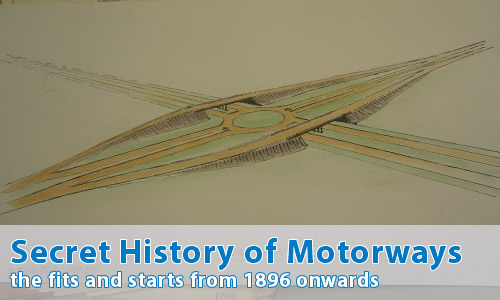The Special Roads Act: 1949 - 1958
The real possibilities for motorways as we know them today came about in 1949, with two occurrences.
Firstly, the Road Plan for Lancashire (developed by Sir James Drake). This was a revolutionary way of looking at road construction within the county as part of economic development and improvements. In order to prepare the Plan, extensive traffic and accident surveys were completed. This meant that there could be real measured justifications for each proposal within the Plan, which included approximately 100 miles of motorway within it - including the now-M6 through the county as well as other proposals such as the Morecambe Link Motorway.
And the other?
The other was the passing of the Special Roads Act 1949.
What's so special about that?
Very funny.
The Special Roads Act is the basic legislation (although it's been updated in the years since) that allows motorways as we know them to be constructed in the United Kingdom. Prior to this Act, any new road immediately became a right of way, open to all traffic - even pedestrians - unless there was specific paperwork banning them. With a Special Road, no-one has the right to use it unless stated. As well as that, no gas mains, water pipes, sewerage mains, electricity cables were allowed to be laid under Special Roads - so no digging them up for maintenance of other things! The Act also allowed for other roads to be either closed or diverted in order to stop them crossing the Special Road.
So what were the first motorways ordered under the Act?
There were four that were passed as part of the Act's passage - the Stevenage Bypass, the Newport (Monmouthshire) Bypass, and either side of the Severn Bridge; with the Port Talbot Bypass following on soon afterwards. However, the first long-distance motorway set was the "North of Twyning - Lydiate Ash Special Road", or part of today's M5.
So, into the 1950s then.
Absolutely - and the decade was marked by the addition of new projects, with the Preston and Lancaster Bypasses in 1953, and in the mid-1950s the addition of:
- London - Yorkshire Motorway (now M1)
- a route from it via the West Midlands to Lancashire (now M6)
- West Midlands to Bristol and South Wales (now M5 and M50)
- London - Monmouthshire via the Severn Bridge (now M4 and M48)
- bypasses for the Medway Towns (A2(M), now M2), Maidstone (A20(M), now M20), Doncaster (A1(M)) and Darlington (A1(M) and A66(M))
Meanwhile, James Drake and Lancashire were busy. They were the first to make use of the provision in the Special Roads Act that meant that local authorities could propose a Special Road with the approval of the Ministry, and so the M62 Stretford-Eccles Bypass was added to the "to do" list. It didn't stay there long, as the first part of motorway construction got underway pretty much straight away. Lancashire County Council had acquired a load of free waste material, which they put to use building up the embankments for the Barton High Level Bridge on that motorway.
By 1956, work had started on the Preston Bypass, whilst in 1957 construction commenced on the Lancaster Bypass, the Stretford-Eccles Bypass and the Chiswick Flyover, now the extreme eastern end of the M4.
Things were really starting to move along.

